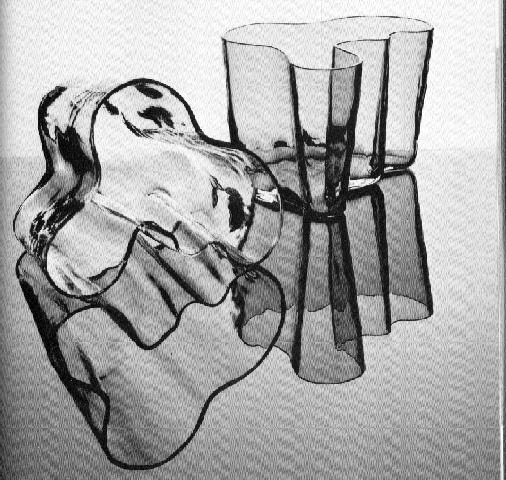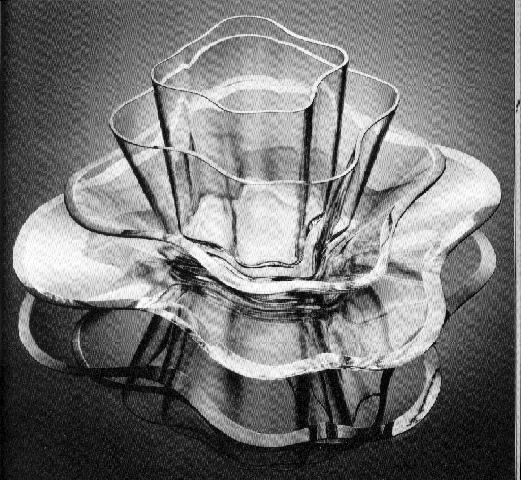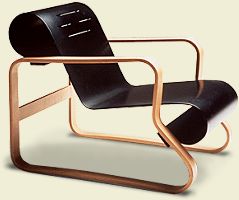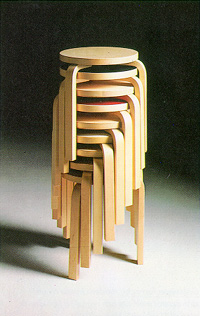

Preface
When studying Alvar Aalto's work it is necessary to
mention his wife Mrs. Aino Aalto, also an architect. Her impact
on Alvar Aalto's glass design was considerable. Although they
both created personal conceptions and objects, their co-operation
in some glass projects was undeniable. This synthesis of creative
power was best realised in their "Aalto Flower" which
combined Alvar Aalto's free, organic line and Aino Aalto's
disciplined practicality.
 Alvar and Aino Aalto as
glass-designers
Alvar and Aino Aalto as
glass-designers
The position of Alvar Aalto as one of the pioneers
of architecture in our century, as a realizer and further
developer of Functionalism, is internationally recognised and
acknowledged. An interesting part in the history of architecture
is his personal development from the classicism of the 1920s to
the severe functionalism of the 1930s, and further to his own,
free architecture based on the harmony of nature and the everyday
needs of man.
Through the significant conceptions of new form and line which
were born while designing furniture, his name has become
important in the history of object design as well. However, one
single object could have guaranteed him his world-wide
reputation: the "Aalto vase". Its unorthodox, free form
reflexes those features typical to all Aalto's design.
Aino and Alvar Aalto glass design together and
independently
Alvar Aalto worked together with his wife Mrs. Aino
Aalto. Miss Aino Marsio was employed in Aalto's office in 1924.
Soon after this they were married and worked together until Aino
Aalto died in 1949.
In the field of architecture it is hard to distinguish between
Aino and Alvar Aalto's individual contribution in design. The
creations were the results of collective planning, obviously
based on Alvar Aalto's ideas. In object designing the situation
is different: the sposes worked, at least partly, on independent
terms. In this area the differences in their personalities and
working methods are clearly apparent. Alvar Aalto was impulsive,
an enchanter in conversation but sometimes even irritating.
The picture of Mrs. Aino Aalto is the opposite. She was a strong
personality, with an utterly down-to-earth mind. As a woman,
mother and the managing director of Artek (a company set up to
promote the selling of Alvar Aalto's and other modern design) she
was a strict realist. In her work she realised the principles of
functionalism: practicality, simplicity, and social aspects and
demands.
Alvar Aalto's interest in object design was clearly seen as early
as in his student years. In 1920, before his graduation in
architecture, he was chosen a member of Ornamo (then: The
Association of Decorative Artists). In the 1920s, his Jyväskylä
off ice did church renovations which also included ecclesiastical
objects from candleholders to altar textiles. For him, objects
always come as a part of architecture and environment, and thus
his furniture and lighting equipment were born in the process of
certain architectural projects.
Alvar Aalto's work as a glass designer was of entirely different
nature. His ideas did not grow in connection with buildings.
Instead, most of his glass objects were born for glass
competitions.
Aino and Alvar Aalto's work with glass concentrates to the 193Os.
The following decade went by with struggle through the war years
and rebuilding, and glass industry did not need new models. Alvar
Aalto's only glass design from this decade is a huge bowl, a
birthday present for his wife in 1944. The 1950s was filled with
architectural schemes and work. A glass ashtray was probably his
only glass object in the 195Os. All glass objects by the Aaltos
have been made at Karhula and Iittala glassworks, except for the
"Riihimäki Flower" in 1933.
Aalto Flower and cocktail plates 1939
 In May, 1938 Alvar Aalto won the competition
about Finland's department for the New York World's Fair. A
dominating feature of the exhibition space was a winding wall of
"will-o'-the-wisps"", a wall that presented
Finland's resources and industrial life with photos.
In May, 1938 Alvar Aalto won the competition
about Finland's department for the New York World's Fair. A
dominating feature of the exhibition space was a winding wall of
"will-o'-the-wisps"", a wall that presented
Finland's resources and industrial life with photos.
For the New York Fair, Alvar and Aino Aalto designed a new glass
object, "Aalto Flower". It was a synthesis of their
earlier glass design. The design was for four separate pieces: a
shallow dish, two bowls and a vase. In their "Riihimäki
Flower" the pieces had been stacked to create a sculptural
flower Now they used the same idea, but with greater freedom of
line, adapting the free form of "Aalto vase" into the
new flower. The freedom of line is, however, more disciplined in
this flower than in their earlier work. In fact, each single
piece of the "Aalto Flower" repeats the same, softly
curving basic line.
In one tries to distinguish between the two designers' individual
contribution to this object, one could say Aino Aalto's practical
mind combines with Alvar Aalto's flying imagination. No wonder,
"Aalto Flower" has become a spectacle in many
exhibitions. The theme of the "Aalto Flower" was
repeated a little later in a series of plates.
At the same time Karhula glassworks produced cocktail plates by
Alvar Aalto. The plates had round depressions for cocktail
snacks. One of the plate types had four round depressions for the
food and one narrow depression for the knife and fork. The second
type had cut edges, three round and one longer depression, i.e.
eyes, nose and mouth. The plate resembled a primitive face mask.
Both "Aalto Flower" and the cocktail plates were
introduced to the Finns for the first time in Helsinki Exhibition
Centre at the Housing Exhibition in 1939. They were on display at
both Karhula glassworks' and Artek's departments. Alvar Aalto had
been chosen chairman of the organisers' committee and was very
enthusiastic about the exhibition. The aim was to present housing
from all angles: social, physiological and psychological. The
exhibition had demanded a great deal of work, but the organisers
were forced to close it only four days after the opening. The
dark clouds of war hang over the world causing restlessness.
Nobody had time to dwell on the problems of architecture and
design.
"An object is made to be completed by the human
mind"
The famous department store NK in Stockholm held an
Alvar Aalto exhibition in 1954. The occasion was an important
Landmark in Aalto's career as a designer, because it exhibited
for the first time his new ideas both in the fields of furniture
and textile design. His fan-leg for furniture, and his
"Venice" and "Siena" interior decoration
textiles were introduced to the general public. A simple
square-shaped plate was also seen in Stockholm. This plate was,
in fact, an adopted reproduct of his cocktail plates with
depressions from 1939. This plate was made in colouriess and
opaque glass.
Although Alvar and Aino Aalto's impact on both architecture and
design was quite unique, beautiful objects as such never became
the purpose of work for either of them. A glass object found its
meaning as a part of the environment. When studying the line and
form of the "Aalto vase", the thoughts of their
designer should always be remembered: "a standard object is
never a finished product: on the contrary, it is made to be
completed by the individual human mind "
Furniture
 Contemporary design is often
criticised for its social exclusiveness and inability to
harmonise with contexts beyond its own narrow aesthetic field.
The strained artistic ideas of our own time have failed to create
a relaxed and comfortable atmosphere. Design today has made a
sharp difference between high culture and popular taste,
concerning itself so much with novelty that it quickly loses its
fashionable appeal.
Contemporary design is often
criticised for its social exclusiveness and inability to
harmonise with contexts beyond its own narrow aesthetic field.
The strained artistic ideas of our own time have failed to create
a relaxed and comfortable atmosphere. Design today has made a
sharp difference between high culture and popular taste,
concerning itself so much with novelty that it quickly loses its
fashionable appeal.
Alvar Aalto's furniture designs are a superb example of the
uncompromising spirit that has managed to overcome the barriers
of style and taste, fashion and social class. Many of his
creations - some approaching their first half-century - are in
greater demand now than ever before. His pieces of furniture are
at once modern and traditional, elegant and cosy. Though
mass-produced they have the pleasing imprint of handicraft and
are equally at home in the domestic surroundings of everyday life
as the magnificent buildings of cultural renown.
 His
designs are not the result of specific planning work. On the
contrary, they evolved in connection with his architectural
projects, deriving from his desire for a comprehensive design
conceived as a total concept from the townscape down to the door
knob. They developed from simple sketches through successive
experiments and improvements to prototypes created in close
collaboration between the architect and the craftsman.
Consequently, only a few of the original sketches and production
drawings remain and it is most difficult to date exactly the
almost five dozen models manufactured.
His
designs are not the result of specific planning work. On the
contrary, they evolved in connection with his architectural
projects, deriving from his desire for a comprehensive design
conceived as a total concept from the townscape down to the door
knob. They developed from simple sketches through successive
experiments and improvements to prototypes created in close
collaboration between the architect and the craftsman.
Consequently, only a few of the original sketches and production
drawings remain and it is most difficult to date exactly the
almost five dozen models manufactured.
lt is believed that Alvar Aalto suddenly appeared in the
forefront of the architectural avant-garde at the end of the
1920s through his convincingly mature and articulate designs in
the international Style. Likewise, that he began his pioneering
work as a furniture designer by immediately producing his
bentwood masterpieces. Both these impressions are wrong. As both
an architect and furniture designer he already had behind him an
impressive decade of work and experimentation in the prevailing
Nordic Classicist style. Until recently precious little was known
about this phase, largely due to obviousness of the classical
roots of modernity, but also Aalto's own deprecation of the
artistic merits of his early works.